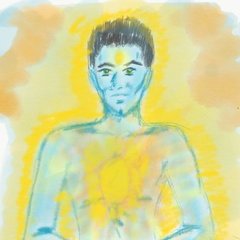-
Content count
8,286 -
Joined
-
Last visited
-
Days Won
70
Everything posted by dwai
-
That is possible to do just as well by balancing the weight between the heels and the balls of the feet. I've seen various versions of this kind of instruction -- "spread the tarsal bones wider, apply more weight/pressure on the K1 point, treat the big toe, K1 point and the center of the heel as 3 nails you've dug into the earth and so on". FWIW, in my experience (and I've been doing this for more than 20 years now) -- the best way to stand in wuji is when you are neither falling forward nor backward -- and your weight simply falls through to the ground. The more important thing to watch out for in wuji stance is really about suspending the crown point, tucking the chin slightly, leaning the torso slightly forward, and letting the chest muscles sink downward. Another thing is to not let your toes splay out -- keep the toes perpendicular to each other or even better, slightly splayed inward.
-
I don’t know about that. Seems to open quite well without physically stretching the area. If you stand “correctly” it doesn’t take much time to start feeling the Qi. Just think about it, if you’re perched up on the balls of your feet for long periods of time (like a ballerina), you essentially are holding a “calf raise”. Why won’t your calf muscles not “burn/sting” or even cramp?
-
If you are unable to wiggle your toes in this position, you’re putting too much weight on the front part of the feet. The weight needs to be distributed evenly between your heels and the balls of the feet.
-
https://www.banyanbotanicals.com/info/ayurvedic-living/living-ayurveda/diet/chyawanprash/
-
Or maybe Vato Loco
-
Indian traditions have a very detailed exposition on the power of sound (Vak). Kashmiri Shaivism presents the concept of matrika chakra (the mother wheel) which shows how the universe manifested from a seed sound. Similar idea also exists in the Vedic tradition as well. http://www.ravikhanna.com/matrika-shakti-as-explained-in-the-shaktopaya-of-the-shiva-sutras/3
-
Or is it a form of samadhi?
-
If they are real monks or yogis, then I doubt if their chants are empty But I don’t consider your yoga booty latte slurping lululemon wearing yoga studio types to even be fake yogis.
-
It works in both directions. Only, we are tracing the breadcrumbs back to the source, so we’re following the reverse path — nivritti. Sound arises from silence — so we’re just reversing the step. In mantra practice, the weakest/lowest level is vocal chanting. Next is mental chanting, and then it is activating the deity/energetic aspect behind the mantra directly. Highest is silence.
-
Actually there are plenty of Hindu priests, monks and initiates who have been trained in the Vedic system that know exactly how to do it. The system hasn’t changed in 1000s of years.
-
actually the vocalized mantra is the lowest level practice. Yes. One method of Advaita Vedanta meditation involves silent meditation on prolonged Om chants.
-
I would venture to say it’s not so. Om is not just a mantra, it is the primordial seed sound, a reverberation of the absolute itself. There is a lot of nuance to “om” and an entire meditation practice is based on simply chanting and meditating on this “sound”. Om comprises of 4 parts - “A” (like the sound aaaaa), “U” (oooo) and “M” (mmmm), followed by an equal measure of silence. When one meditates on Om in the vedantic way, one is performing a sacrificial ritual of sorts, into silence and stillness. A represents the waking state and the waking world. U represents dream state and the dreaming world, M represents the silence of deep sleep and absence of phenomena therein. In the chanting of Om one goes from the manifest world to the unmanifest. The silence is that which in which the waking, Dreaming and deep sleep states arise and fall. When you articulate Om as AUM, you can see how it correlates to going from the manifest to unmanifest. It is the power of three lineages/ancient traditions of the world - Hindu, Buddhist and Jain. So no, “One” is not as effective as Om in my humble opinion
-
Saw this video clip recently about Brain scan
-
Personalized mantras contain a transmission by the teacher in the traditional context. While one can certainly pick a mantra for practice, a teacher who has unlocked the power of a mantra can accelerate a student’s growth by initiating them.
-
When I learned it, it was 100$ per head (back in 2003 or so). I think if one can afford it, it is a very powerful method to learn. I would ascribe the high price to the huge amount of community welfare/outreach programs the organization runs. I don't know much about him but I think he's the Shankaracharya of Dwaraka Peeth (which is located in Dwaraka, in Gujarat (western state in India) and not Jyotir Math (which is the one in North India, in the Himalayas).
-
I know a few people who've been associated with the TM movement. I agree, the price tag is very high. But the method is effective from what I heard. Two famous members from Maharishi Mahesh Yogi's inner circle of disciples are Deepak Chopra and Sri Sri Ravishankar. Both have developed organizations which have massive following -- and are responsible for mainstreaming many of the things that were taught in the TM tradition. While this might be hagiographical, this Wikipedia page outlines MMY's background/lineage -- https://en.wikipedia.org/wiki/Maharishi_Mahesh_Yogi He certainly has the background -- and iinm, he was selected to become the Shankaracharya (head pontiff) of the Jyotir Math - one of the four main seats of Hinduism established by Adi Shankaracharya in the 8th century AD. I practice Sri Sri Ravishankar's Sudarshan Kriya Yoga and it is very powerful. I suppose that TM is pretty powerful too. Many western "awakened" people have been TM students. It really boils down to one's proclivities and karmic predilection when it comes to the success/failure in pursuing any given spiritual path.
-
I'd venture to say that your assailant picked you both because he thought he could get something from you by intimidating/threatening you. What could you tell about the person based on your observation? His body language, his articulation/diction, etc? What about the kind of clothes he wore? Did he have "backup"? Were there actually others that showed up/lurking around from different angles towards where you were facing this person? I know it's not a good idea to "judge a book by its cover", but sometimes appearances can be helpful to determine what kind of trouble you might have been getting yourself into. About 10 years ago, I was attending a tech conference in San Francisco downtown (Moscone Center), and had two colleagues with me. As we finished up the evening session, we started walking towards Market St (which is the "center of Downtown SF" iirc). It was around 7:15 pm, and as we stood on the other side of Market St., waiting to cross, I noticed a group of young men suddenly perk up as they saw us (there weren't too many people there at the time). From the looks of it, they were hanging on the street. One look at them and I noticed that they were" targeting" us for something. They got up and suddenly broke into 2-3 groups in different directions. As we crossed the street, my colleagues, oblivious to what was going on, ambled along, chatting. I told them to pretend like nothing has happened, but walk real fast. We increased our speed and walked to the alleyway towards the garage where I had parked my car. The garage was almost empty, with not another person in sight. As we got into the car, I locked the doors and windows, and pulled out of the garage, I saw two of those groups converge at the same alleyway we had recently crossed. My colleagues were still mystified as to what had happened, wondering what got into my craw to make them walk so fast. I pointed to those guys as we drove past and told them we'd have been mugged if we hadn't hurried. It is always best to walk away from a bad situation. It's also a good idea to be aware of what's going on around us (situational awareness). Not from a state of paranoia, but from a perspective of awareness.
-
A physicist was asked “what is Mind?” He replied, “No matter”. So then he was asked, “so what is matter then?” He replied, “Never mind…”
-
My teeth usually (Apparently I love my collagen)
-
I did not learn how to knit. Might not be a bad idea for finger dexterity. Thanks for the suggestion.
-
I find it happens to me when I’m more invested in situations beyond what is necessary. A good sign for me is if I’m thinking about something more frequently than I normally do. The “taking personally” seems to be a side-effect of “wanting” something (to happen/not happen). And the recourse (for me) is to just “observe” the patterns arise/subside.
-
Well…clearly! 😇
-
Stay far away from Clyman. His material is not safe imho. If it doesn’t mess you up energetically it’ll mess your mind up.
-
Wow what’s a translation cake? Is it as delicious as it sounds? Seems like the cake isn’t translating properly into English. So you’re out here promoting your Facebook group? If so, do share some reasons why someone should spend their time reading your delicious translations?
-
I see. And what do you “experience” in nirvikalpa samadhi? Please do share your personal experiences. While you’re at it, also do tell us what you meant by yin reduction and vacuum. Very interested to learn what that means. which Buddhist scripture(s) are you referring to? And which Taoist one(s)? Help me understand what you’re saying. Share a few names/commentaries etc — but please don’t quote reams of text here. Now, this is not the kind of attitude that’ll give you much mileage out here. Better to be kind — no matter how ignorant someone might seem to you — it’s a sign of maturity. But it’ll be interesting to read your take on what samadhi is like. Which kind of samadhi, and so on. Best wishes, dwai





